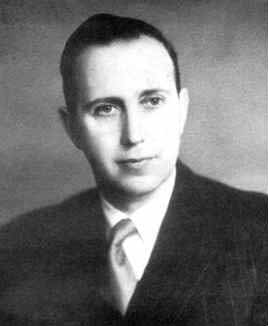

تاريخ الرياضيات

الاعداد و نظريتها

تاريخ التحليل

تار يخ الجبر

الهندسة و التبلوجي


الرياضيات في الحضارات المختلفة

العربية

اليونانية

البابلية

الصينية

المايا

المصرية

الهندية


الرياضيات المتقطعة

المنطق

اسس الرياضيات

فلسفة الرياضيات

مواضيع عامة في المنطق


الجبر

الجبر الخطي

الجبر المجرد

الجبر البولياني

مواضيع عامة في الجبر

الضبابية

نظرية المجموعات

نظرية الزمر

نظرية الحلقات والحقول

نظرية الاعداد

نظرية الفئات

حساب المتجهات

المتتاليات-المتسلسلات

المصفوفات و نظريتها

المثلثات


الهندسة

الهندسة المستوية

الهندسة غير المستوية

مواضيع عامة في الهندسة

التفاضل و التكامل


المعادلات التفاضلية و التكاملية

معادلات تفاضلية

معادلات تكاملية

مواضيع عامة في المعادلات


التحليل

التحليل العددي

التحليل العقدي

التحليل الدالي

مواضيع عامة في التحليل

التحليل الحقيقي

التبلوجيا

نظرية الالعاب

الاحتمالات و الاحصاء

نظرية التحكم

بحوث العمليات

نظرية الكم

الشفرات

الرياضيات التطبيقية

نظريات ومبرهنات


علماء الرياضيات

500AD

500-1499

1000to1499

1500to1599

1600to1649

1650to1699

1700to1749

1750to1779

1780to1799

1800to1819

1820to1829

1830to1839

1840to1849

1850to1859

1860to1864

1865to1869

1870to1874

1875to1879

1880to1884

1885to1889

1890to1894

1895to1899

1900to1904

1905to1909

1910to1914

1915to1919

1920to1924

1925to1929

1930to1939

1940to the present

علماء الرياضيات

الرياضيات في العلوم الاخرى

بحوث و اطاريح جامعية

هل تعلم

طرائق التدريس

الرياضيات العامة

نظرية البيان
Arthur Geoffrey Walker
المؤلف:
The Times, 2001
المصدر:
The Times, 2001
الجزء والصفحة:
...
15-10-2017
375
Born: 17 July 1909 in Watford, Hertfordshire, England
Died: 31 March 2001 in Chichester, Sussex,England

Geoffrey Walker's father was Arthur John Walker (born in Watford, Hertfordshire in 1879) who was a coach builder. His mother was Eleanor Joanna Gosling (born in Watford, Hertfordshire in 1879; died 1946). Geoffrey Walker had an older brother Henry Brian Walker who was born about 1907 and died in Hendon, Middlesex in 1968.
Geoffrey Walker attended Watford Grammar School and from there, having won a mathematics scholarship in his final year, he entered Balliol College, Oxford. He received a First Class degree from Oxford in 1931, having specialised in differential geometry for which he won a special distinction. He remained at Merton College, supported by a Harmsworth scholarship during 1932-34 and he also held an Oxford University senior mathematics scholarship in 1933. In his final years at Oxford he was greatly influenced by Milne. Leaving Oxford, he then moved to Edinburgh to undertake research.
After submitting his Ph.D. thesis to Edinburgh, Walker was examined by Eddington. After the award of his doctorate he was appointed as a lecturer in mathematics at Imperial College in London. This was a post for the academic year 1935-36 and after completing this temporary appointment he received his first permanent post as a lecturer in mathematics at Liverpool University. He was appointed in 1936 and was to remain in Liverpool until 1947 when he was offered the chair of mathematics at the University of Sheffield.
In 1952, after five years in Sheffield, Walker was to return to Liverpool University, this time as Professor of Pure Mathematics. He held this post until he retired in 1974. However, the pressures of administration in this post restricted his time for research:-
He was a very able administrator and had the happy gift of "reading down the diagonal", as he termed it. This meant that when presented with a massive document he could extract the essential features in a very short time. His colleagues had great respect for his integrity, and as a result he found himself on numerous committees which diminished his time and energy for research.
Walker worked on geometry, in particular differential geometry, relativity, and cosmology. His papers include ones on relativistic mechanics, completely symmetric spaces, completely harmonic spaces and Riemannian manifolds. He wrote an article Note on locally symmetric vector fields in a Riemannian space,published in 1976, in memory of Evan Tom Davies. This is concerned with the restrictions imposed on a Riemannian n-space by the existence of a locally symmetric vector field and it continues work begun by Walker in a paper on possible orientation of galaxies published early in his career in 1940.
In 1962 Walker published Harmonic Spaces, a joint work with H S Ruse and T J Willmore. In 1975 he published Introduction to geometrical cosmology a survey which arose out of a course that Walker gave at the University of Arizona. The lectures consider the red-shift, the number of galaxies, and the distance between galaxies. Walker writes in the introduction:-
This is an account of a course of 12 lectures given at the University of Arizona on the geometry of cosmology. It is entirely concerned with what might be called the classical theory, leading up to and discussing the standard model with the Robertson-Walker metric; it contains no new results though some of the methods may not have appeared in print.
The Robertson-Walker metric which Walker mentions in this quotation arose from joint work which he did with his colleague H P Robertson in the late 1930s. Their work put Friedmann's theories of an expanding universe on a sound mathematical foundation and still forms the basis for models of the universe in modern cosmology.
Walker was elected both a fellow of the Royal Society of Edinburgh and a fellow of the Royal Society of London. The Royal Society of Edinburgh honoured Walker by awarding him their Keith Medal in 1950. The election to the Royal Society of London took place in 1955 and he served on the Council of the Society in 1962-63. He was also a strong supporter of the London Mathematical Society and was awarded the Junior Berwick Prize of that Society in 1947. He served the Society by being the 50th President in 1963-65.
In [1] some of Walker's interests outside mathematics are recorded:-
A popular head of department, he will be remembered as one of the most powerful of British differential geometers, but he was also outstanding as a table-tennis player, and some proficiency at the game was sometimes said to be a necessary qualification for employment as a lecturer in Liverpool.
Unknown to most of his colleagues, he and his wife Phyllis were accomplished ballroom dancers, and he once surprised a friend by saying that he had won more prizes for dancing than he had for mathematics.